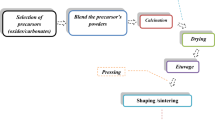Abstract
Based on nominal components, Sr4+x Ca1−x BiTi3Nb7O30 (x = 0.25, 0.5, 0.75, 1) ceramics were prepared by means of solid-state reaction method. Their transition temperatures T m can be experimentally tuned by controlling the atomic ratio of Sr2+/Ca2+. All the samples are demonstrated to exhibit relaxor ferroelectric property above room temperature, and T m can be controlled effectively by changing the content of Sr2+ ion in A1 site. In addition, the linear relation between T m and the x corresponding to Sr2+ ion of A1 site indicates that relaxor ferroelectric with wide-ranging transition temperatures can be obtained, catering for the potential applications. Meanwhile, the dielectric maximum temperature T m of relaxation-I obeyed the Vogel–Fulcher law well, and Curie–Weiss fitting confirmed the displacive-type ferroelectric phase transition in these compounds.






Similar content being viewed by others
References
Zhang JJ, Zhai JW, Yao X (2009) Dielectric tunable properties of low-loss Ba0.4Sr0.6Ti1−y Mn y O3 ceramics. Scr Mater 61:764–767
Feteira A, Sinclair DC, Reaney IM, Somiya Y, Lanagan MT (2004) BaTiO3-based ceramics for tunable microwave applications. J Am Ceram Soc 87:1082–1087
Irvin P, Levy J, Guo R, Bhalla AS (2005) Three-dimensional polarization imaging of (Ba, Sr)TiO3:MgO composites. Appl Phys Lett 86:042903
Xiang F, Wang H, Li KC, Chen YH, Zhang MH, Shen ZY, Yao X (2007) Dielectric tunability of Ba0.6Sr0.4TiO3/poly(methyl methocrylate) composites in 1-3-type structure. Appl Phys Lett 91:192907
Zhou K, Boggs SA, Ramprasad R, Aindow M, Erkey C, Alpay SP (2008) Dielectric response and tunability of a dielectric-paraelectric composite. Appl Phys Lett 93:102908
Samara GA (2003) The relaxational properties of compositionally disordered ABO3 perovskites. J Phys 15:R367–R411
Zhu XL, Li K, Rafiq MA, Liu XQ, Chen XM (2013) Relaxor nature in lead-free Sr5LaTi3Nb7O30 tetragonal tungsten bronze ceramics. J Appl Phys 114:124102
Levin I, Stennett MC, Miles GC, Woodward DI, West AR, Reaney IM (2006) Coupling between octahedral tilting and ferroelectric order in tetragonal tungsten bronze-structured dielectrics. Appl Phys Lett 89:122908
Li K, Zhu XL, Liu XQ, Chen XM (2012) Effects of Ca-substitution on structural, dielectric, and ferroelectric properties of Ba5SmTi3Nb7O30 tungsten bronze ceramics. Appl Phys Lett 101:042906
Gong GS, Zerihun G, Fang YJ, Huang S, Yin CY, Yuan SL (2015) Relaxor behavior and large room-temperature polarization of ferroelectric Sr4CaBiTi3Nb7O30 ceramics. J Am Ceram Soc 98(1):109–113
Zhu XL, Chen XM, Liu XQ (2008) Dielectric relaxations, ultrasonic attenuation, and their structure dependence in Sr4(LaxNd1−x )2Ti4Nb6O30 tungsten broneze ceramics. J Mater Res 23(11):3112–3121
Sun YH, Chen XM, Zheng XH (2004) Tungsten bronze type dielectrics in SrO-Sm2O3-TiO2-Nb2O5 system and their dielectric anomaly. J Appl Phys 96(12):7435–7439
Zhu X, Fu M, Stennett MC, Vilarinho PM, Levin I, Randall CA, Gardner J, Morrison FD, Reaney IM (2015) A crystal-chemical framework for relaxor versus normal ferroelectric behavior in tetragonal tungsten bronzes. Chem Mater 27:3250–3261
Viehland D, Jang SJ, Cross LE (1990) Freezing of the polarization fluctuations in lead magnesium niobate relaxors. J Appl Phys 68:2916–2921
Zhu XL, Li K, Chen XM (2014) Ferroelectric transition and low-temperature dielectric relaxations in filled tungsten bronzes. J Am Ceram Soc 97(2):329–338
Zhu XL, Chen XM (2014) Ferroelectric transition and Curie–Weiss behavior in some filled tungsten bronze ceramics. Chin Phys Lett 31(1):015201
Li K, Zhu XL, Liu XQ, Chen XM (2013) Re-entrant relaxor behavior of Ba5RTi3Nb7O30 (R = La, Nd, Sm) tungsten bronze ceramics. Appl Phys Lett 102:112912
Li K, Zhu XL, Liu XQ, Chen XM (2012) Relaxor ferroelectric characteristics of Ba5LaTi3Nb7O30 tungsten bronze ceramics. Appl Phys Lett 10:012902
Acknowledgements
This work was supported by the Natural Science Foundation of China (Grant Nos. 61571403, 11174092, 11474111, 51002144) and Key Project of He’nan Educational Committee (Grant No. 14A140019).
Author information
Authors and Affiliations
Corresponding authors
Rights and permissions
About this article
Cite this article
Gong, G., Wang, Y., Liu, D. et al. Lead-free relaxor ferroelectric ceramics Sr4+x Ca1−x BiTi3Nb7O30 with tunable transition temperature. J Mater Sci 51, 7336–7342 (2016). https://doi.org/10.1007/s10853-016-0018-1
Received:
Accepted:
Published:
Issue Date:
DOI: https://doi.org/10.1007/s10853-016-0018-1




